Consideration of Grappling & Wrestling in Renaissance Fencing
Part 1
By John Clements, ARMA Director
Editor’s Note: The reader should note that
this article contains some quotations taken from old English whose spelling
is quite different
from our modern counterpart. 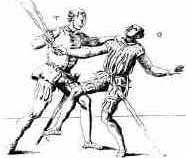 The
skills of grappling and the art of wrestling have a long legacy in Europe.
In the early 1500s, many soldiers, scholars, priests, and nobles wrote
that wrestling was important in preparing aristocratic youth for military
service. The detailed depictions of unarmed techniques in many Medieval
fencing manuals (such as those by Fiore Dei Liberi and Hans Talhoffer)
are well known and accounts of wrestling and grappling abound in descriptions
of 15th century tournaments and judicial contests. A 1442 tournament
fight in Paris "with weapons as we are accustomed to carrying in
battle" included in its fourth article the stipulation "that
each of us may help each other with wrestling, using legs, feet, arms
or hands." English knightly tournaments as late as 1507 allowed
combatants "To Wrestle all maner of wayes" or to fight "with
Gripe, or otherwise". The Hispano-Italian master Pietro Monte in
the 1480’s even recognized wrestling as the "foundation of
all fighting", armed or unarmed. Albrecht Duerer’s Fechtbuch
of 1512 contains more material on wrestling than on swordplay, yet the
relationship between them is noticeable. The oldest known fencing text,
the late 13th century treatise MS I.33, even states, "For when one
will not cede to the other, but they press one against the other and
rush close, there is almost no use for arms, especially long ones, but
grappling begins, where each seeks to throw down the other or cast him
on the ground, and to harm and overcome him with many other means." But
just how all this heritage relates to the foyning fence of the Renaissance
is less well understood. This has been an area traditionally overlooked
by enthusiasts and it is understandable that many enthusiasts have come
to the wrong conclusions. The
skills of grappling and the art of wrestling have a long legacy in Europe.
In the early 1500s, many soldiers, scholars, priests, and nobles wrote
that wrestling was important in preparing aristocratic youth for military
service. The detailed depictions of unarmed techniques in many Medieval
fencing manuals (such as those by Fiore Dei Liberi and Hans Talhoffer)
are well known and accounts of wrestling and grappling abound in descriptions
of 15th century tournaments and judicial contests. A 1442 tournament
fight in Paris "with weapons as we are accustomed to carrying in
battle" included in its fourth article the stipulation "that
each of us may help each other with wrestling, using legs, feet, arms
or hands." English knightly tournaments as late as 1507 allowed
combatants "To Wrestle all maner of wayes" or to fight "with
Gripe, or otherwise". The Hispano-Italian master Pietro Monte in
the 1480’s even recognized wrestling as the "foundation of
all fighting", armed or unarmed. Albrecht Duerer’s Fechtbuch
of 1512 contains more material on wrestling than on swordplay, yet the
relationship between them is noticeable. The oldest known fencing text,
the late 13th century treatise MS I.33, even states, "For when one
will not cede to the other, but they press one against the other and
rush close, there is almost no use for arms, especially long ones, but
grappling begins, where each seeks to throw down the other or cast him
on the ground, and to harm and overcome him with many other means." But
just how all this heritage relates to the foyning fence of the Renaissance
is less well understood. This has been an area traditionally overlooked
by enthusiasts and it is understandable that many enthusiasts have come
to the wrong conclusions.
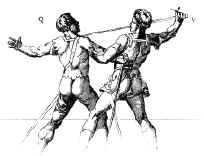 Nonetheless, all historical armed combat (Medieval and Renaissance,
cutting or thrusting) involved some degree of grappling and wrestling
techniques. But, as few Renaissance fencing manuals include detailed
sections on grappling and wrestling or even discuss seizures and disarms,
the popular view has been that they were not used or were viewed with
disdain. Besides, aren’t unarmed and pugilistic attacks merely
unskilled "thuggery" practiced only by the lower classes? After
all, surely one should not need to wrestle if one knows the sword "to
perfection"? (…and yet how many are "perfect" with
their sword, we might ask?). Nonetheless, all historical armed combat (Medieval and Renaissance,
cutting or thrusting) involved some degree of grappling and wrestling
techniques. But, as few Renaissance fencing manuals include detailed
sections on grappling and wrestling or even discuss seizures and disarms,
the popular view has been that they were not used or were viewed with
disdain. Besides, aren’t unarmed and pugilistic attacks merely
unskilled "thuggery" practiced only by the lower classes? After
all, surely one should not need to wrestle if one knows the sword "to
perfection"? (…and yet how many are "perfect" with
their sword, we might ask?).
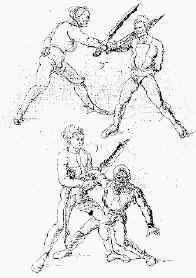 This common view makes perfect sense, after all, as a slender cut-and-thrust
sword or rapier is a weapon whose characteristics are perfectly suited
to keeping an opponent off and killing him at range. Intentionally closing-in
to resort to hands-on brute strength would seem antithetical to the very
nature and advantage of the weapon. In actuality, the matter is that
such actions were not primitive, but advanced techniques that required
considerable practice and skill to execute –and knowing them could
make a fighter a more well-rounded and dangerous opponent in combat.
Yet, fencing historians have typically seen these advanced techniques
as being crudities and mere "tricks". Part of this prejudice
perhaps stems from the surviving 18th & 19th century view of swordplay
as being essentially that of personal "duel of honor" or gentlemanly
private quarrel. The traditional focus there has been on fencing as "blade
on blade" action rather than on "fighting" with swords
in battle or sudden urban assault. This was not the case in the 1500’s
and 1600’s. Armed fighting ranged from all manner of encounters
with all manner of bladed weapons. This common view makes perfect sense, after all, as a slender cut-and-thrust
sword or rapier is a weapon whose characteristics are perfectly suited
to keeping an opponent off and killing him at range. Intentionally closing-in
to resort to hands-on brute strength would seem antithetical to the very
nature and advantage of the weapon. In actuality, the matter is that
such actions were not primitive, but advanced techniques that required
considerable practice and skill to execute –and knowing them could
make a fighter a more well-rounded and dangerous opponent in combat.
Yet, fencing historians have typically seen these advanced techniques
as being crudities and mere "tricks". Part of this prejudice
perhaps stems from the surviving 18th & 19th century view of swordplay
as being essentially that of personal "duel of honor" or gentlemanly
private quarrel. The traditional focus there has been on fencing as "blade
on blade" action rather than on "fighting" with swords
in battle or sudden urban assault. This was not the case in the 1500’s
and 1600’s. Armed fighting ranged from all manner of encounters
with all manner of bladed weapons.
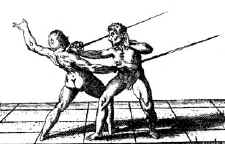 Yet, because approval of grappling and wrestling in the period was inconsistent
and often curtailed during fencing practice, understanding its true value
can be confusing now for students unfamiliar with either the actual evidence
or the actual techniques. In the early 1500’s the Italian solider-priest
Celio Calacagnini listed wrestling as an exercise required for preparing
upper-class youths for military service. In 1528, the courtier Baldassare
Castiglione wrote, " it is of the highest importance to know how
to wrestle, since this often accompanies combat on foot." In 1531
the English scholar and diplomat Sir Thomas Elyot wrote, "There
be divers maners of wrastlinges" and "undoubtedly it shall
be founde profitable in warres, in case that a capitayne shall be constrayned
to cope with his aduersary hande to hande, hauyng his weapon broken or
loste. Also it hath ben sene that the waiker persone, by the sleight
of wrastlyng, hath ouerthrowen the strenger, almost or he coulde fasten
on the other any violent stroke." In 1575, Michel de Montaigne,
the French Renaissance thinker, essayist, and courtier, wrote "our
very exercises and recreations, running, wrestling …and fencing".
In the notorious 1547 duel between the nobles Jarnac and Chastaignerai,
Jarnac was so concerned at Chastaignerai’s well known skill as
a wrestler (not to mention fencing) that to avoid the chance of a close
struggle, he insisted both parties each wear two daggers. Alfred Hutton’s
account from Vulson de la Colombière’s in 1549 of a judicial
combat between one D’aguerre and Fendilles states, "D’aguerre
let fall his sword, and being an expert wrestler (for be it understood
that no one in those days was considered a complete man-at-arms unless
he was proficient in the wrestling art), threw his enemy, held him down,
and, having disarmed him of his morion, dealt him many severe blows on
the head and face with it…". Yet, because approval of grappling and wrestling in the period was inconsistent
and often curtailed during fencing practice, understanding its true value
can be confusing now for students unfamiliar with either the actual evidence
or the actual techniques. In the early 1500’s the Italian solider-priest
Celio Calacagnini listed wrestling as an exercise required for preparing
upper-class youths for military service. In 1528, the courtier Baldassare
Castiglione wrote, " it is of the highest importance to know how
to wrestle, since this often accompanies combat on foot." In 1531
the English scholar and diplomat Sir Thomas Elyot wrote, "There
be divers maners of wrastlinges" and "undoubtedly it shall
be founde profitable in warres, in case that a capitayne shall be constrayned
to cope with his aduersary hande to hande, hauyng his weapon broken or
loste. Also it hath ben sene that the waiker persone, by the sleight
of wrastlyng, hath ouerthrowen the strenger, almost or he coulde fasten
on the other any violent stroke." In 1575, Michel de Montaigne,
the French Renaissance thinker, essayist, and courtier, wrote "our
very exercises and recreations, running, wrestling …and fencing".
In the notorious 1547 duel between the nobles Jarnac and Chastaignerai,
Jarnac was so concerned at Chastaignerai’s well known skill as
a wrestler (not to mention fencing) that to avoid the chance of a close
struggle, he insisted both parties each wear two daggers. Alfred Hutton’s
account from Vulson de la Colombière’s in 1549 of a judicial
combat between one D’aguerre and Fendilles states, "D’aguerre
let fall his sword, and being an expert wrestler (for be it understood
that no one in those days was considered a complete man-at-arms unless
he was proficient in the wrestling art), threw his enemy, held him down,
and, having disarmed him of his morion, dealt him many severe blows on
the head and face with it…".
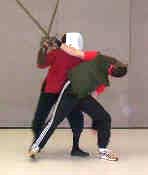 A Ritterakedemie or "Knight’s School" was reportedly
set up in 1589 at Tübingen in Germany to instruct aristocratic youths
in skills which included wrestling, fencing, riding, dancing, tennis,
and firearms. Joachim Meyer offered significant elements of grappling
and wrestling with swords in his Fechtbuch of 1570 and in the 1580’s
the French general Francois de la Noue advocated wrestling in the curriculum
of military academies and the famed chronicler of duels, Brantome, also
tells us that wrestling was highly regarded at the French court. The
Bolognese master, Lelio de Tedeschi, even produced a manual on the art
of disarming in 1603. In 1625, Englishman Richard Peeke fought in a rapier
duel at Cadiz, defeating the Spaniard Tiago by sweeping his legs out
from under him after trapping his blade with his hilt. In 1617 Joseph
Swetnam commented on the value of skill in wrestling for staff fighting.
But as Dr. Anglo has pointed out, in 1622, Englishman Henry Peacham questioned
whether "throwing and wrestling" were more befitting common
soldiers rather than nobility, while his contemporary Lord Herbert of
Cherbury who studied martial arts in France, found them "qualities
of great use". At the turn of the 17th century in France, the celebrated
rapier duelists Lagarde and Bazanez came into conflict (the celebrated "duel
of the hat") and ended up on the ground violently stabbing and fighting
each other. A Ritterakedemie or "Knight’s School" was reportedly
set up in 1589 at Tübingen in Germany to instruct aristocratic youths
in skills which included wrestling, fencing, riding, dancing, tennis,
and firearms. Joachim Meyer offered significant elements of grappling
and wrestling with swords in his Fechtbuch of 1570 and in the 1580’s
the French general Francois de la Noue advocated wrestling in the curriculum
of military academies and the famed chronicler of duels, Brantome, also
tells us that wrestling was highly regarded at the French court. The
Bolognese master, Lelio de Tedeschi, even produced a manual on the art
of disarming in 1603. In 1625, Englishman Richard Peeke fought in a rapier
duel at Cadiz, defeating the Spaniard Tiago by sweeping his legs out
from under him after trapping his blade with his hilt. In 1617 Joseph
Swetnam commented on the value of skill in wrestling for staff fighting.
But as Dr. Anglo has pointed out, in 1622, Englishman Henry Peacham questioned
whether "throwing and wrestling" were more befitting common
soldiers rather than nobility, while his contemporary Lord Herbert of
Cherbury who studied martial arts in France, found them "qualities
of great use". At the turn of the 17th century in France, the celebrated
rapier duelists Lagarde and Bazanez came into conflict (the celebrated "duel
of the hat") and ended up on the ground violently stabbing and fighting
each other.
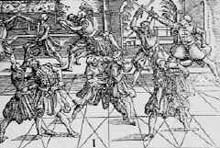 |
 |
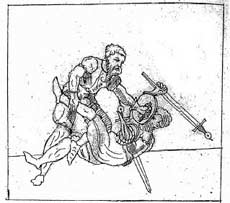 There is evidence close-in techniques were excluded from the German
Fechtschulen events of the 1500s where, in order to perform safe displays,
rules were in place to prevent such techniques. Similarly, the 1573 Sloane
manuscript of the London Masters of Defence states that in Prize Playing
events "who soever dothe play agaynst ye prizor, and doth strike
his blowe and close withall so that the prizor cannot strike his blowe
after agayne, shall Wynn no game for anny Veneye". The implication
in such cases is that while closing and seizing is effective and understood,
it is inappropriate for the public display intended to show a student’s
skill at defending and delivering blows. In 1579, Heinrich Von Gunterrodt
noted that "Fencing is a worthy, manly, and most noble Gymnastic
art, established by principles of nature…which serves both gladiator
and soldier, indeed everyone, in …battles, and single-combats,
with every hand-to-hand weapon, and also wrestling, for strongly defending,
and achieving victory over." Von Gunterrodt, also observed: in fencing, "when
one will not cede to the other, but they press one against the other
and rush close, there is almost no use for arms, especially long ones,
but grappling begins, where each seeks to throw down the other or cast
him on the ground, and to harm and overcome him with many other means." There is evidence close-in techniques were excluded from the German
Fechtschulen events of the 1500s where, in order to perform safe displays,
rules were in place to prevent such techniques. Similarly, the 1573 Sloane
manuscript of the London Masters of Defence states that in Prize Playing
events "who soever dothe play agaynst ye prizor, and doth strike
his blowe and close withall so that the prizor cannot strike his blowe
after agayne, shall Wynn no game for anny Veneye". The implication
in such cases is that while closing and seizing is effective and understood,
it is inappropriate for the public display intended to show a student’s
skill at defending and delivering blows. In 1579, Heinrich Von Gunterrodt
noted that "Fencing is a worthy, manly, and most noble Gymnastic
art, established by principles of nature…which serves both gladiator
and soldier, indeed everyone, in …battles, and single-combats,
with every hand-to-hand weapon, and also wrestling, for strongly defending,
and achieving victory over." Von Gunterrodt, also observed: in fencing, "when
one will not cede to the other, but they press one against the other
and rush close, there is almost no use for arms, especially long ones,
but grappling begins, where each seeks to throw down the other or cast
him on the ground, and to harm and overcome him with many other means."
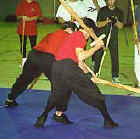 George Silver’s views of 1599 advocating "gryps and seizures" in
swordplay are well known. Interestingly though, Silver lamented how such
things were no longer being taught by teachers of defence, saying "…there
are now in these dayes no gripes, closes, wrestlings, striking with the
hilts, daggers, or bucklers, used in Fence-schools". However, Silver
also describes situations which are quite familiar and reasonable to
those who today practice rapier fencing with more inclusive guidelines
for intentional close-contact. Silver, in his Paradoxes of Defence, section
31, actually complains that the rapier’s excessive length allows
for close-in fighting without much fear because there is little threat
to prevent it once the point is displaced. He writes: "Of the single
rapier fight between valiant men, having both skill, he that is the best
wrestler, or if neither of them can wrestle, the strongest man most commonly
kills the other, or leaves him at his mercy". He then describes
what happens typically when the fighters both rush together, explaining: George Silver’s views of 1599 advocating "gryps and seizures" in
swordplay are well known. Interestingly though, Silver lamented how such
things were no longer being taught by teachers of defence, saying "…there
are now in these dayes no gripes, closes, wrestlings, striking with the
hilts, daggers, or bucklers, used in Fence-schools". However, Silver
also describes situations which are quite familiar and reasonable to
those who today practice rapier fencing with more inclusive guidelines
for intentional close-contact. Silver, in his Paradoxes of Defence, section
31, actually complains that the rapier’s excessive length allows
for close-in fighting without much fear because there is little threat
to prevent it once the point is displaced. He writes: "Of the single
rapier fight between valiant men, having both skill, he that is the best
wrestler, or if neither of them can wrestle, the strongest man most commonly
kills the other, or leaves him at his mercy". He then describes
what happens typically when the fighters both rush together, explaining:
"When two valiant men of skill at single rapier do fight, one or
both of them most commonly standing upon their strength or skill in wrestling,
will presently seek to run into the close…But happening both of
one mind, they rather do bring themselves together. That being done,
no skill with rapiers avail, they presently grapple fast their hilts,
their wrists, arms, bodies or necks, as in …wrestling, or striving
together, they may best find for their advantages. Whereby it most
commonly false out, that he that is the best wrestler, or strongest
man (if neither
of them can wrestle) overcomes, wrestling by strength, or fine skill
in wrestling, the rapier from his adversary, or casting him from him,
wither to the ground, or to such distance, that he may by reason thereof,
use the edge or point of his rapier, to strike or thrust him, leaving
him dead or alive at his mercy."
In his section 34, Of the long single rapier, or rapier and poniard
fight between two unskillful men being valiant, Silver also observes:
"When two unskillful men (being valiant) shall fight with long
single rapiers, there is less danger in that kind of fight, by reason
of their distance in convenient length, weight, and unwieldiness,
than is with short rapiers, whereby it comes to pass, that what hurt
shall
happen to be done, if any with the edge or point of their rapiers
is done in a moment, and presently will grapple and wrestle together,
wherein
most commonly the strongest or best wrestler overcomes, and the like
fight falls out between them, at the long rapier and poniard, but
much more deadly, because instead of close and wresting, they fall
most commonly
to stabbing with their poniards."
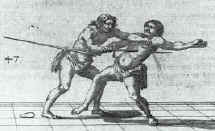 Of course, some might argue Silver was not a "rapier master" and
so did not understand "proper" fencing. Regardless, he was
obviously an experience, highly skilled martial artist and expert swordsman
who had seen valid methods of rapier fighting in actual use. Then there
is the case of "Austin Bagger, a very tall gentleman of his hands,
not standing much upon his skill" who Silver describes as having
with his sword and buckler fought the "Italian teacher of offense",
Signior Rocco with his two hand sword. Silver relates how Bagger "presently
closed with him, and struck up his heels, and cut him over the breech,
and trod upon him, and most grievously hurt him under his feet." Which
means he charged forward, swept his legs out from under him, slashed
his rear, and then stomped on him a few times while he was down. Of course, some might argue Silver was not a "rapier master" and
so did not understand "proper" fencing. Regardless, he was
obviously an experience, highly skilled martial artist and expert swordsman
who had seen valid methods of rapier fighting in actual use. Then there
is the case of "Austin Bagger, a very tall gentleman of his hands,
not standing much upon his skill" who Silver describes as having
with his sword and buckler fought the "Italian teacher of offense",
Signior Rocco with his two hand sword. Silver relates how Bagger "presently
closed with him, and struck up his heels, and cut him over the breech,
and trod upon him, and most grievously hurt him under his feet." Which
means he charged forward, swept his legs out from under him, slashed
his rear, and then stomped on him a few times while he was down.
 Hutton tells us how in the year 1626, the Marquis de Beuvron and Francois
de Montmorency, Comte de Boutteville, the notorious rabid duelist and
bully, fought a duel together in which both attacked "each other
so furiously that they soon come to such close quarters that their long
rapiers are useless. They throw them aside, and, grappling with one another,
attempt to bring their daggers into play." In 1671 an affray took
place in Montreal, Canada, between Lieutenant de Carion and Ensign de
Lormeau. While walking home with his wife, de Lormeau was confronted
by de Carion backed by two friends. Provoked into fighting by de Carion,
both men drew swords and exchanged blows. De Lormeau was wounded three
times, including wounds to the head and arm. Both wrestled briefly before
de Carion struck de Lormeau repeatedly on the head with his pommel. They
were then separated by some five passing onlookers and both combatants
survived. Hutton tells us how in the year 1626, the Marquis de Beuvron and Francois
de Montmorency, Comte de Boutteville, the notorious rabid duelist and
bully, fought a duel together in which both attacked "each other
so furiously that they soon come to such close quarters that their long
rapiers are useless. They throw them aside, and, grappling with one another,
attempt to bring their daggers into play." In 1671 an affray took
place in Montreal, Canada, between Lieutenant de Carion and Ensign de
Lormeau. While walking home with his wife, de Lormeau was confronted
by de Carion backed by two friends. Provoked into fighting by de Carion,
both men drew swords and exchanged blows. De Lormeau was wounded three
times, including wounds to the head and arm. Both wrestled briefly before
de Carion struck de Lormeau repeatedly on the head with his pommel. They
were then separated by some five passing onlookers and both combatants
survived.
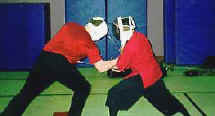 Closing in to strike, to grab, trip, throw, or push the opponent down
is seen in countless Renaissance fencing manuals from the cut-and-thrust
style swords of Marozzo in 1536 to the slender rapier of Giovanni Lovino
in 1580 and that of L'Lange in 1664. Jacob Wallhausen’s 1616 depictions
of military combat (armored and unarmored) show much the same. Dr. Sydney
Anglo calls this desperate armed or unarmed combat "all-in fighting" as
opposed to formal duels with rules, and describes it as: "one other
area of personal combat which was taught by masters throughout Europe,
and was practiced at every level of the social hierarchy whether the
antagonists were clad in defensive armor or not". He adds that, "Even
in Spain, where it might be thought that mathematical and philosophical
speculation had eliminated such sordid realities, wrestling tricks were
still taught by the masters –as well illustrated in early seventeenth-century
manuscripts treatises by Pedro de Heredia, cavalry captain and member
of the war council of the King of Spain". Heredia’s illustrations
of rapier include several effective close-in actions that hark back to
similar techniques of Marozzo and even Fiore Dei Liberi in 1410. Closing in to strike, to grab, trip, throw, or push the opponent down
is seen in countless Renaissance fencing manuals from the cut-and-thrust
style swords of Marozzo in 1536 to the slender rapier of Giovanni Lovino
in 1580 and that of L'Lange in 1664. Jacob Wallhausen’s 1616 depictions
of military combat (armored and unarmored) show much the same. Dr. Sydney
Anglo calls this desperate armed or unarmed combat "all-in fighting" as
opposed to formal duels with rules, and describes it as: "one other
area of personal combat which was taught by masters throughout Europe,
and was practiced at every level of the social hierarchy whether the
antagonists were clad in defensive armor or not". He adds that, "Even
in Spain, where it might be thought that mathematical and philosophical
speculation had eliminated such sordid realities, wrestling tricks were
still taught by the masters –as well illustrated in early seventeenth-century
manuscripts treatises by Pedro de Heredia, cavalry captain and member
of the war council of the King of Spain". Heredia’s illustrations
of rapier include several effective close-in actions that hark back to
similar techniques of Marozzo and even Fiore Dei Liberi in 1410.

The chronicler of duels, Brantome, tells us of a judicial duel in the
mid-1500’s wherein the Baron de Gueerres fought one Fendilles.
Having received a terrible thrust in the thigh, the Baron availed himself
of his wrestling skills and "closed with his antagonist and bore
him to the ground; and there the two lay and struggled". He also
relates a sword & dagger duel between the Spanish Captain Alonso
de Sotomayor and the knight Bayard. After some figting Sotomayor missed
a thrust which Bayard answered by deeply piercing his throat that he
could not withdraw his weapon. Sotomayor was still able to grapple with
Bayard so that both fell where Bayard then managed to stab Sotomayor
in the face with his dagger.
Some would still give us the impression today that personal combat in
the Renaissance consisted only of cavaliers and courtiers formally dueling
each other and apparrently no gentleman or courtier in the period ever
fought under any other condition or for any other reason other than affairs
of honor. Of course, it must be thoroughly understood that it was the
Renaissance aristocracy who were primarily recording accounts of duels
and frays and who naturally wrote almost exclusively about combats among
their own social class. Naturally, proper duels (illegal or not) were
far more interesting to them than everyday fights (by gentry or commoner)
which garnered neither reputation nor honor. But the actual evidence
from the period suggests a very different character than a conception
of simple "honorable" swordplay.
Continued in Part 2
About The Author:
John Clements is an authority on historical fencing and one of the world’s
foremost practitioners of Medieval and Renaissance fencing. He is a long-time
martial-artist who has been studying historical fencing since 1980. He
has practiced cut & thrust swordsmanship and rapier fighting for
more than eighteen years. John has researched swords and arms in 8 countries
and taught sword seminars in 6 countries. Since summer 1997 he has taught
public courses and private lessons in Houston. He has authored numerous
articles on swords and weapon fighting for several magazines including:
Renaissance Magazine, Tactical Knives, Karate International, Histoire'
Medievale, L’art de la Guerre, Master at Arms, The
Sword, Hammerterz
Forum, Hop-Lite, and Sword Forum International. John was also major contributor
on historical fencing as well as member of the editorial board to the
new Martial Arts of the World encyclopedia from ABC-CLIO Press (October
2001). He has also authored five books including: Medieval Swordsmanship:
Illustrated Methods & Techniques (Paladin Press, Nov ’98) and
Renaissance Swordsmanship: The Illustrated Use of Rapiers and Cut-and-Thrust
Swords (Paladin Press, March '97). John has also been featured twice
on The History Channel, and was the creator and a founding member of
the original Swordplay Symposium International. In 1982 he founded the
Medieval Battling Club. John is the Director of The Association
For Renaissance Martial Arts (ARMA), where this article was originally
featured.
|